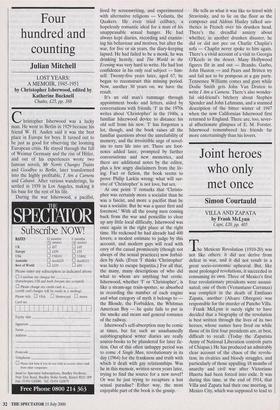Joint heroes
who only met once
Simon Courtauld
VILLA AND ZAPATA by Frank McLynn Cape, £20, pp. 405 The Mexican Revolution (1910-20) was not like others: it did not derive from defeat in war, and it did not result in a great socio-economic upheaval. But, like most prolonged revolutions, it succeeded in consuming its own. Three of Mexico's first four revolutionary presidents were assassi- nated; one of them (Venustiano Carranza) was complicit in the death of Emiliano Zapata, another (Alvaro Obregon) was responsible for the murder of Pancho Villa.
Frank McLynn is surely right to have decided that a biography of the revolution is best written through the lives of its two heroes, whose names have lived on while those of its first four presidents are, at best, difficult to recall. (Today the Zapatista Army of National Liberation controls parts of Chiapas.) He has produced an admirably clear account of the chaos of the revolu- tion, its rivalries and bloody struggles, and particularly of those appalling 18 months of anarchy and civil war after Victoriano Huerta had been forced into exile. It was during this time, at the end of 1914, that Villa and Zapata had their one meeting, in Mexico City, which was supposed to lead to an alliance between north and south. But it never got off the ground.
Almost the only thing they had in com- mon was their devotion to women or, rather, to womanising. Both of them con- tracted bogus 'marriages' with a variety of mistresses and sired numerous children. The youngest of Villa's sons, born shortly after he was shot dead (while visiting a mis- tress), would be in his seventies today. But there was no meeting of minds between the Centaur of the North and the Attila of the South over revolutionary strategy. Part of the problem was that Villa was always hap- pier in his native Chihuahua, and Zapata never looked beyond his home state of Morelos. From Mexico City the two togeth- er could probably have delivered a knock- out blow to Carranza, then lurking in Veracruz, but instead Villa headed north, while Zapata was concerned, in McLynn's words, only with 'achieving peasant Utopia in his beloved Morelos'.
Unlike the other major participants, Zapata was a true revolutionary, but he had no national vision. Villa was not a socialist: land reform to him meant taking it from the old hacendados and giving it to his followers. 'I would never fight for the equality of the social classes,' he once said. But for nine years he fought and fought and fought again — in pitched battles at Torreon and Zacatecas (his most memo- rable victories), in suicidal cavalry charges involving thousands of casualties, in raids all over the desert and mountain state of Chihuahua, and most famously in his invasion of United States territory in March 1916.
In the early stages of the civil war Woodrow Wilson had looked favourably on Villa (he never took Zapata seriously), but when the USA recognised Carranza as president in October 1915 Villa was deter- mined to teach those gringos a lesson. The farcical 'punitive expedition' to capture Villa, following his raid on Columbus, New Mexico, had to be abandoned after 11 months, during which Villa went on marauding at will and no one betrayed his whereabouts, even for a reward of US $50,000. The US commander, General 'Blackjack' Pershing, must have been great- ly relieved to be ordered to take his troops to the Western Front instead of continuing to flounder about in the Mexican desert. McLynn could have made more of Ger- many's scheming with Mexico to keep the USA out of the war in Europe which is chronicled so fascinatingly in Barbara Tuchman's The Zimmermann Telegram. It was said that a German agent joined Villa's staff shortly before the Columbus incident, and that while Villa was eluding Pershing the German consul in Ciudad Juarez always knew where he was to be found.
Zapata did not start looking at the bigger Picture until shortly before his death, and by this time Carranza had brought into being a new constitution which gave him rather more powers than the pre- revolutionary Porfirio Diaz had enjoyed. As McLynn indicates, the one intelligent moderate who might have achieved a mea- sure of peace and justice for the country was the cosmopolitan scholar and thinker, and villista general, Felipe Angeles. (Intel- lectuals were attracted more to the 'Robin Hood' bandit Villa than to the peasant rev- olutionary Zapata.) He worked hard for a Villa-Zapata alliance and he might have been the man to lead a government of national reconciliation. Carranza, of course, realised this and arranged for Angeles to go the way of almost all Mexi- can revolutionary leaders in those brutal years.



























































 Previous page
Previous page